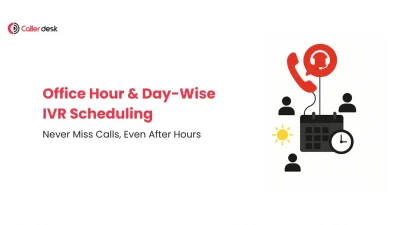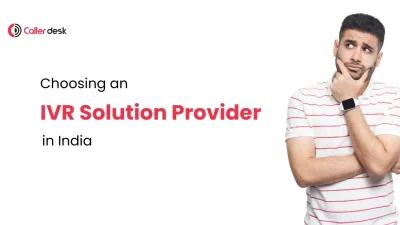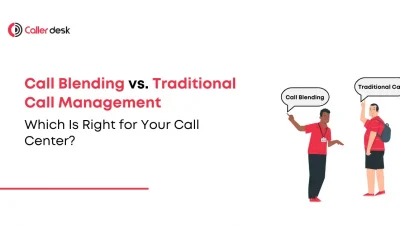Customer service is the backbone of successful businesses. A positive interaction with your call center can turn first-time buyers into loyal customers, while a negative experience can lead to lost sales and reputational damage. Studies show that 60% of customers are more likely to make repeat purchases from companies that provide excellent customer service. But how can call centers efficiently manage both customer support and sales operations without compromising quality?
Call blending offers a solution. This innovative approach allows call centers to handle both inbound (customer support) and outbound (sales and follow-up) calls seamlessly. By leveraging advanced technology, call blending optimizes resource utilization, reduces costs, and enhances the overall customer experience.
In this guide, we’ll walk you through the step-by-step process of implementing call blending in your call center, discuss its key benefits, and show you how CallerDesk’s solutions can make a measurable difference.
What is Call Blending?
Call blending enables agents to manage both inbound and outbound calls dynamically. It uses advanced tools like Automated Call Distribution (ACD) and Interactive Voice Response (IVR) to allocate tasks in real-time based on demand and priority.
How Call Blending Works
Imagine a symphony orchestra where musicians seamlessly switch between instruments to create the perfect harmony. Similarly, call blending ensures that agents are always engaged with the most pressing tasks, reducing idle time and improving efficiency.
Key Components:
- Dynamic Call Routing: Ensures incoming calls are directed to the most suitable agents based on availability, skillset, and customer needs.
- Automated Task Switching: During periods of low inbound call volume, agents are assigned outbound tasks like sales or follow-ups.
- Integrated Systems: CRM tools, ACD, and IVR work together to provide agents with real-time data, enabling them to deliver personalized and efficient service.
Key Benefits of Call Blending
Call blending is a game-changer for modern call centers, offering numerous advantages:
1. Improved Resource Utilization
By filling idle time with outbound tasks, call blending ensures agents are always productive. For instance, during off-peak hours, agents can focus on lead generation or customer follow-ups.
2. Enhanced Customer Satisfaction
With dynamic call routing, customers experience shorter wait times and quicker resolutions. Satisfied customers are more likely to remain loyal and recommend your business to others.
3. Cost Efficiency
Combining inbound and outbound operations into a single team eliminates the need for separate staffing. This reduces overhead costs while maintaining high service quality.
4. Increased Revenue Opportunities
Call blending enables agents to upsell or cross-sell during inbound calls and pursue outbound sales leads. For example, a retail business using call blending saw a 20% increase in sales leads within three months.
5. Better Team Morale
The variety of tasks in a blended environment keeps agents engaged and reduces burnout. Additionally, cross-training equips agents with versatile skills, boosting confidence and job satisfaction.
6. Actionable Insights Through Analytics
Advanced call blending software provides real-time reporting, helping managers track key performance indicators (KPIs) like average handle time, first call resolution, and customer satisfaction.
Step-by-Step Guide to Implementing Call Blending
Step 1: Define Clear Objectives
Identify what you want to achieve with call blending. Are you looking to reduce wait times, increase sales, or improve customer satisfaction?
Checklist for Needs Assessment:
- What are your current call center challenges?
- Which KPIs need improvement?
- How will success be measured?
Step 2: Invest in Advanced Technology
The right technology is essential for seamless call blending.
Key Tools to Implement:
- Automated Call Distribution (ACD): Routes calls efficiently to reduce customer wait times.
- Interactive Voice Response (IVR): Offers self-service options and routes calls based on customer input.
- CRM Integration: Provides agents with instant access to customer data for personalized interactions.
- Predictive Dialers: Automates outbound calling, reducing idle time and boosting call volume.
CallerDesk Advantage: With CallerDesk, you get a feature-rich platform that includes AI-powered call routing, omnichannel support, and seamless CRM integration to ensure smooth operations.
Step 3: Train Your Agents
Equip your agents with the skills and tools needed to succeed in a blended environment.
Training Best Practices:
- Provide hands-on training for call blending tools and software.
- Focus on communication, problem-solving, and multitasking skills.
- Offer ongoing coaching to ensure continuous improvement.
Step 4: Monitor and Optimize Performance
Track performance metrics regularly to identify areas for improvement.
Key Metrics to Monitor:
- First Call Resolution (FCR): Measures how often issues are resolved on the first call.
- Average Handle Time (AHT): Tracks the efficiency of call handling.
- Call Abandonment Rate: Identifies potential bottlenecks in call routing.
- Customer Satisfaction (CSAT): Gauges how well customer needs are being met.
Step 5: Encourage Team Collaboration
In a blended environment, teamwork is essential for success.
Tips for Collaboration:
- Host regular team meetings to share best practices.
- Use collaboration tools to enhance communication between agents.
- Celebrate team successes to boost morale.
Why Choose CallerDesk for Call Blending?
CallerDesk stands out as a leader in call center solutions, offering tools designed to simplify and enhance call blending.
Unique Features:
- AI-Powered Resource Allocation: Predicts call volumes and optimizes agent workloads.
- Seamless CRM Integration: Ensures agents have real-time access to customer data.
- Omnichannel Support: Unifies interactions across phone, email, chat, and social media.
- Advanced Analytics Dashboards: Provides actionable insights to drive performance.
- Scalable Solutions: Adapts to the needs of growing businesses.
Customer Success Story:
A healthcare provider implemented CallerDesk’s call blending solution and achieved a 30% reduction in wait times while increasing patient satisfaction scores by 25%.
Conclusion
Call blending is a powerful strategy for improving call center efficiency, boosting customer satisfaction, and increasing revenue. By following this guide and leveraging tools like CallerDesk, your call center can deliver exceptional results and stay ahead in today’s competitive market.
Ready to transform your call center? Schedule a free demo with CallerDesk today and see how our call blending solutions can revolutionize your operations.
Frequently asked questions
1. What is call blending, and why is it important for call centers?
Call blending is a call center strategy where agents handle both inbound and outbound calls seamlessly. It ensures optimal resource utilization, reduces agent idle time, and improves customer satisfaction. By dynamically routing tasks, call blending helps businesses manage fluctuating call volumes efficiently while enhancing productivity and revenue growth.
2. How does call blending improve agent productivity?
Call blending minimizes idle time by dynamically assigning tasks based on real-time call volume. Agents seamlessly transition between handling customer queries (inbound) and making sales or follow-up calls (outbound), ensuring they remain engaged and productive throughout their shifts.
3. What technology is essential for implementing call blending?
Key technologies for successful call blending include:
Automated Call Distribution (ACD): Routes calls to the right agents.
Interactive Voice Response (IVR): Provides self-service options for customers.
CRM Integration: Offers real-time access to customer data.
Predictive Dialers: Automates outbound calling to maximize agent efficiency.
These tools ensure seamless task allocation and effective call management.
4. How does call blending enhance customer satisfaction?
Call blending reduces wait times by routing incoming calls to the most suitable agent. It also allows agents to proactively follow up with customers during downtime, addressing concerns promptly and providing a personalized experience. This improves customer loyalty and satisfaction.
5. Can small businesses benefit from call blending?
Yes, small businesses can significantly benefit from call blending. It helps optimize limited resources, reduce costs, and improve customer service. With tools like cloud-based call center software, even small teams can handle fluctuating call volumes effectively and grow their business.
6. What are the key metrics to track for call blending success?
To measure the effectiveness of call blending, monitor these metrics:
First Call Resolution (FCR): Indicates how often issues are resolved on the first call.
Average Handle Time (AHT): Measures call efficiency.
Call Abandonment Rate: Tracks how often customers disconnect before speaking to an agent.
Customer Satisfaction (CSAT): Reflects overall service quality.
7. Why should businesses choose CallerDesk for call blending solutions?
CallerDesk offers AI-powered call blending features, seamless CRM integration, and omnichannel support to optimize call center operations. Its advanced analytics tools provide actionable insights, helping businesses improve efficiency, increase revenue, and enhance customer satisfaction.





